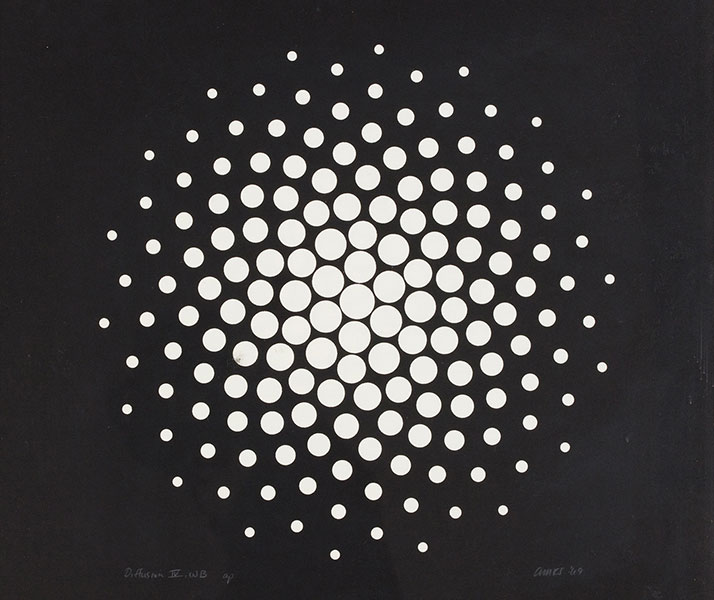
An Artful Year
In 2012, five alumnae artists had major exhibitions in galleries and museums.
By Sarah Achenbach ’88
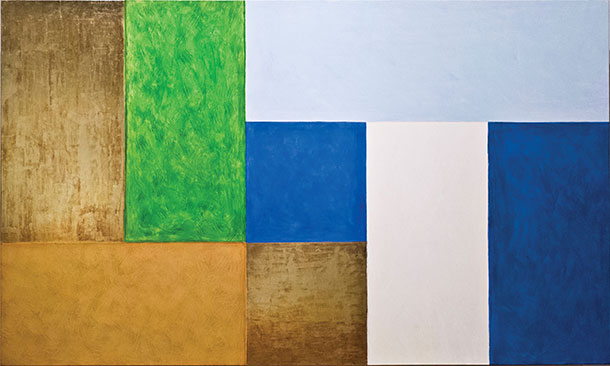
Mary Obering, TBY, 2011, egg tempera and gold leaf on gessoed masonite, 36 x 60 inches, courtesy of Barbara Mathes Gallery.
Mary Obering ’59
Hollins major: Psychology
Exhibit: Untitled, June 29 – September 3, 2012
Barbara Mathes Gallery, New York City
Abstract painter Mary Obering blends traditional Renaissance techniques of egg tempera and gold leaf with rigorous formalism influenced by American minimalism. Her work can be found in museum and private collections worldwide, from the Whitney and Museum of Fine Arts Boston to Ellen DeGeneres’s collection. Since her first exhibition in Denver in 1971, Obering has shown in solo and group shows in the U.S., Costa Rica, and Europe.
“I am attracted to pure abstract art because there is no subject matter per se. It’s all about the relationships of colors and shapes. I was a psychology major at Hollins, in some ways because of the logic of it. It opened my mind to so many things and inspired my love of geometric abstraction.”
—Mary Obering
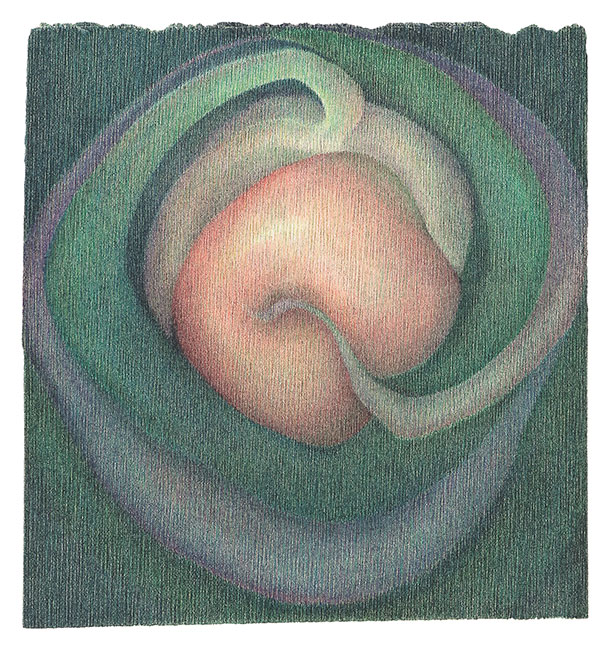
Susan Cofer, Becoming, 1999, colored pencil on paper, courtesy of the artist. (detail)
Susan Seydel Cofer ’64
Hollins major: Art
Exhibit: Draw Near
October 27, 2012 – January 27, 2013
High Museum of Art, Atlanta
Draw Near, Susan Cofer’s first career retrospective of her abstract drawings, brought together nearly 100 of her drawings from 1975 to the present, rendered exquisitely in colored pencil. As a young mother in the late 1960s, she developed “carving” with short vertical lines to evoke shape. Desperate to paint but unable to find the time with small children and fascinated by nature’s tiniest details, she began sketching at night as a meditative response to her day. Nearly 50 years later, her drawings, talent, and singular perspective have earned her renown throughout the Southeast.
“The idea of making a line and leaving a space came out of those early years when you notice that space between yourself and others or between yourself and yourself. Each piece in the show took at least two months or years to do, and some represent a real battle to understand composition or to make form with color. It’s like raising children who are bad but in the end you think they’re just great. Every drawing is the same: I am desperate to tell someone what I want to say. The mere act of doing art is optimism. You know there is imperfection—I always begin with an imperfectly torn piece of paper—but what you hope is that the viewer will add the missing piece.”
—Susan Seydel Cofer
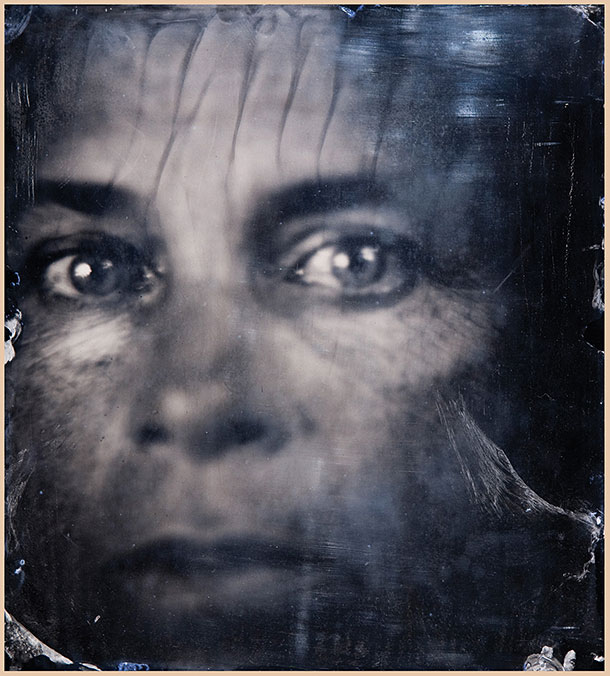
Untitled (Self-Portrait), 2006-12. © Sally Mann/Courtesy of Edwynn Houk Gallery, New York. (detail)
Sally Mann ’74, M.A. ’75
Hollins undergraduate major: English
Graduate degree: writing
Exhibit: Upon Reflection
September 13 – November 3, 2012
Edwynn Houk Gallery, New York City
Named “America’s Best Photographer” by Time magazine in 2001, Sally Mann is a Guggenheim Fellow, three-time recipient of a National Endowment for the Arts award, author of seven books, and the subject of two Academy Award-nominated films. Widely exhibited and collected, her photographs capture the human form and natural world with arresting imagery and sculptural beauty. With Upon Reflection, an accident was the catalyst as she turned her lens onto her most personal subject matter to date: her own mortality. On August 6, 2006, while she was riding in the Blue Ridge Mountains near Lexington, Virginia, her horse suffered an aneurysm and fell, landing on top of her. In his dying struggle to get up, the stallion pummeled Mann’s back. With her body badly damaged, and unable to haul a camera around as before, she began photographing her face and torso. These self-portraits—ethereal, direct, and deliberately flawed—continued long after she healed, resulting in more than 200 ambrotypes, a re-interpretation of a 19th-century glass-plate-making process. Each image is a wet-plate positive on a black sheet of glass. The images are then installed in groupings of three to 75 plates.
“Being limited physically was a driving factor, along with the sudden intellectual and emotional apprehension of my mortality. When [the printing technique] was used originally, none of the process’ flaws were allowed to reveal themselves. I am allowed to free that process from the constriction of convention.
“Every time I put work on the walls, it’s put on there with some level of personal vulnerability. My landscapes are likely considered to be the most objective, but everything else is deeply subjective, deeply emotional. That’s the thing about being an artist—you put it out there. With Upon Reflection, even though it was self-portraiture, I was strangely aloof about these pictures. I was just another subject. A lot of people don’t want to see the aging process exaggerated, but I don’t mind pointing it out.”
—Sally Mann
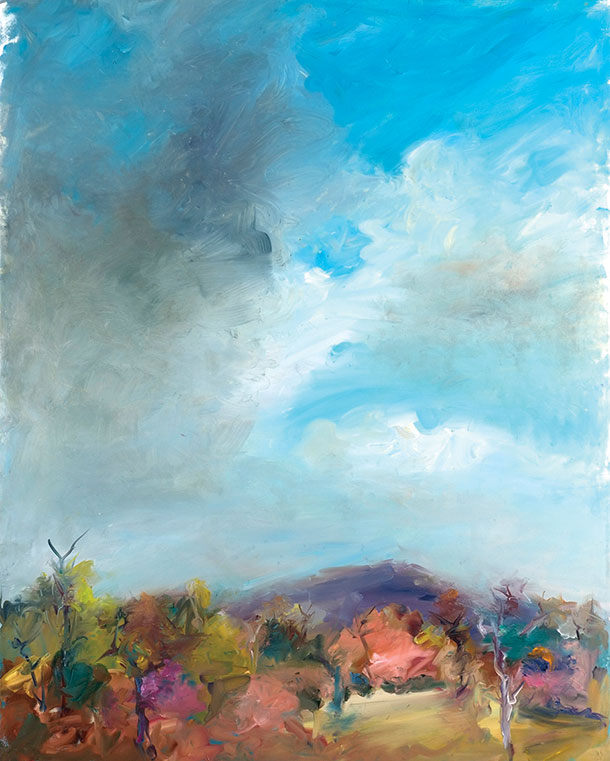
Mary Page Evans, Dark Side, 2011, oil on canvas, 60 x 48 inches. (detail)
Mary Page Hilliard Evans ’59
Hollins major: Music
Exhibit: Painted Poetry: The Art of Mary Page Evans
March 31 – July 15, 2012
Delaware Art Museum, Wilmington
Mary Page Evans’s vibrant, exaggerated palette and lyrical movement of line capture the mercurial qualities of the movement and light in the natural world. Her retrospective, Painted Poetry, featured roughly 50 paintings and drawings over the course of her 40-plus-year career of solo and group shows in the mid-Atlantic and Florida. Inspired by the creative expression that comes when artistic disciplines intersect, poets Elizabeth Seydel Morgan ’60 and Barbara Crooker read their poetry as part of several events celebrating Evans’s retrospective. Evans has painted the autumn leaves of the Shenandoah Mountains, Delaware’s coastal skies, the flowers in Monet’s gardens at Giverny, and all manner of landscapes in between. Her work hangs in public, private, and corporate collections around the country, including three pieces in the Washington, D.C., residence of Vice President Joe Biden.
“I am a failed musician, which led into art. For me, all the arts come together and relate to nature. I love the cross-pollination. I get great joy from my work, even if I am not joyful when I paint it. I want it to work spatially—what’s going to come forward and what is going to stay in the background. I love the immediacy of nature. It’s all so expressionistic, all about feeling. You’re making order out of chaos…and it’s just as important what you exclude as what you include.”
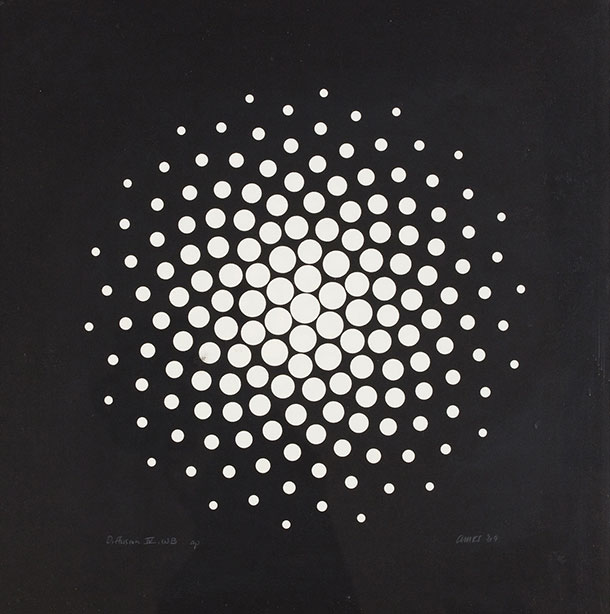
Anne Kesler Shields, Diffusion IV WB, 1969, silkscreen, 14 x 13.5 inches.
Anne Kesler Shields ’54
Hollins major: Studio art
Exhibit: Anne Kesler Shields: 50-Year Retrospective
A three-venue exhibit in Winston-Salem, North Carolina, at the Salem College Fine Arts Center, the Southeastern Center for Contemporary Art, and Wake Forest University’s Hanes Gallery
September 14, 2012 – January 6, 2013,
Shortly after her graduation from Hollins and until her death on October 6, 2012, Anne Kesler Shields was a guiding and inspirational force in the development of Winston-Salem’s arts community. Shields’s talent in portraiture propelled her into the national art world with commissions across the country. Equally skilled in collage, printmaking, abstract painting, and landscape, she enjoyed numerous solo and group exhibitions in the Southeast, including a show at the Eleanor D. Wilson Museum at Hollins in 2006.
“It’s hard not to feel that a tremendous hole has opened in the Winston-Salem art community now that Anne Kesler Shields is no longer with us. And yet she is more alive than ever in the legacy she leaves, the doors she has opened, and the influence that cultivates a new generation of art and artists in this region. We may never see a person of such dedication and longevity again, but in everything that she has done, she has made imagining that thought possible. A career retrospective offers the unique opportunity to reflect on the past, meditate upon the present, and imagine the future. No more worthy or compelling a subject for such a turn through history could there be than Anne Kesler Shields. Her vitality, curiosity, and ambition only increased with age, provoking necessary dialogues, giving voice to women in art and art history, and providing a model for generations to follow.”
—Steven Matijcio, curator of contemporary art, Southeastern Center for Contemporary Art, Winston-Salem, North Carolina
